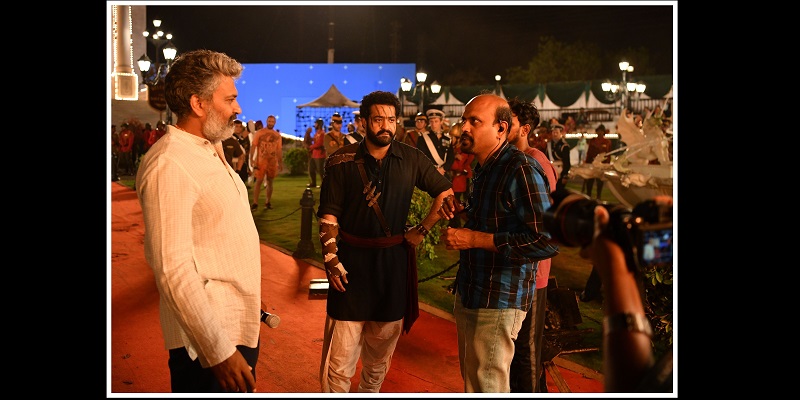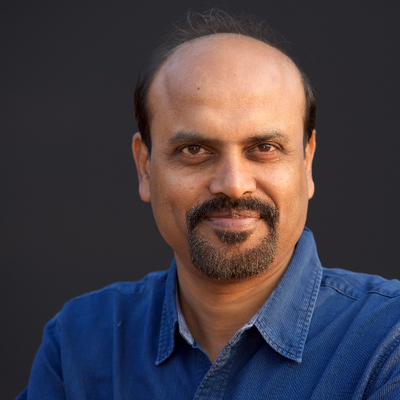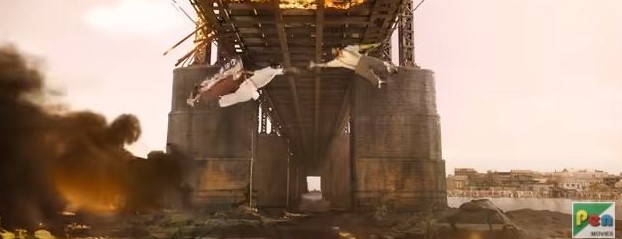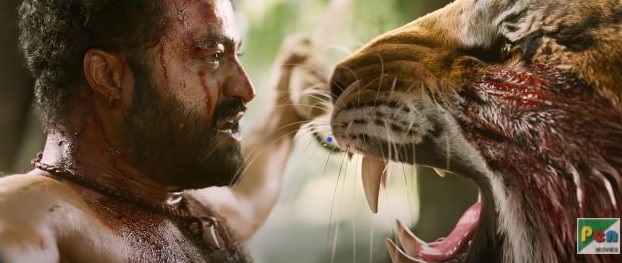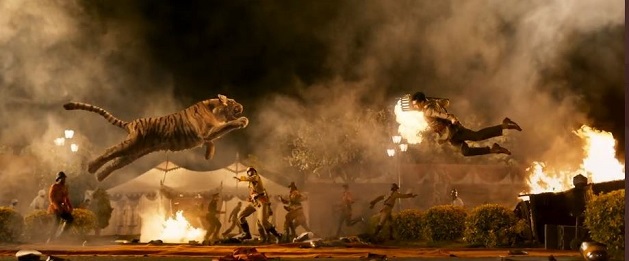Crossing the Rs 1,000 crore-mark at the box office worldwide is no new feat for filmmaker S S Rajamouli. He had set new records with his iconic period fantasy tales Baahubali: The Beginning and Baahubali 2 and his latest work, RRR, is already setting new records. With the pandemic outbreak and the movie-makers opting for OTT releases, the visual-effects heavy film has quenched the thirst of cinema-lovers.
Visual effects veteran Srinivas Mohan, who has worked on Baahubali: The Beginning, served as the VFX producer and supervisor for this project and was involved right after the script got in place. He became an integral part of the shoot and led 18 studios, delivering 2,800 VFX shots. He revealed to Animation Xpress that 70-80 per cent of the shots were done using CGI, which he termed as invisible effects. Mohan’s prior planning ensured seamless coordination. He also shared about the unique challenge of creating the ‘photorealistic creatures’ in the patriotic saga which is about the two legendary revolutionaries (Komaram Bheem aka Bheema and Alluri Sitarama Raju aka Rama) and their journey away from home before they started fighting for their country in 1920’s. RRR also features Alia Bhatt, Ajay Devgn and Samuthirakani in crucial roles.
“The overall quality has improved so much in Indian cinema that we can now push the boundaries to the next level. Baahubali was a work of fantasy, in Robot 2.0 where I worked with director S. Shankar and Rajinikanth had acted, the quality of visuals effects was of high standards, but people could still see the visual effects due to huge birds which were not real characters. But in RRR, my challenge was to make everything invisible and as photorealistic as possible. That way we reached the next level of visual effects,” Mohan told Animation Xpress during a telephonic interview.
He threw light on the meticulous and elaborate work that made RRR an onscreen delight. The scene-by-scene discussion gives quite an in-depth picture of what went behind the cameras and the charisma that visual effects bring to the table.
The bridge sequence
Most of the iconic sequences like the bridge sequence where there is a blast followed by the first encounter of the protagonists Rama and Bheema played by Ram Charan and Jr NTR, respectively, required three to four months of pre-production work. The jumping scene, coming down to rescue the child and meeting under-water, required a lot of understanding of the entire mechanism including the height of the bridge and so on.
A lot of reference shots were taken followed by the concept art to get the natural feel of the surrounding.
“Based on the concept and bridge details, we did the pre-visualisation of the action, where the fall of the kid, train blast and everything was done in 3D. After this we knew which were the camera angles and the DOP locked them. All these were in place before the shoot began,” he said.
Then the entire sequence was shot against a green screen. For the bridge sequence, a small water pond and two pillars were put up on the sets.
Mohan praised the director who ensured that all the artists were comfortable with the shoot and such an extensive pre-vis work made everyone aware of the action sequence. Hence, the shooting of these scenes became less daunting.
“For this sequence we also used miniatures. We had miniatures in the blast sequence, which was shot and rest was done using CGI. Overall if you see the bridge sequence, 90 per cent of it is CGI,” he mentioned.
For RRR, the VFX supervisor was very clear about breathing life into the rich imagination which Rajamouli wanted to bring on screen. And for that, artists were hired from all around the world to ensure finesse. Denmark-based studio Surpreeze was on board for the bridge sequence and around 15 artists worked continuously for almost two years.
Invisible VFX and photorealistic creatures
The VFX-magnum opus Baahubali: The Beginning was first of its kind in Indian cinema. The grandeur of the fantasy world was new. But for RRR it was more about invisible VFX, because this film was totally about the two characters and their emotions played a pivotal role. The understanding between the director and VFX supervisor made this project smooth for the visual effects team.
The period drama explored the theme of fire and water, which formed the major crux of the crucial scenes in the film.
Mohan revealed that Makuta VFX had worked on many shots, MPC was taken on board for Bheema’s introduction scene involving the tiger, and the later scene when he breaks in along with the animals, it was done by ReDefine.
“The uniqueness of RRR was that it required invisible effects as it is not a fantasy. It had to have a realistic feel, which is quite challenging,” he revealed.
The tiger facing the actor had to be perfectly done with fur details, movements and everything for an aesthetic appeal. A lot of digital iteration was done for the creature work. They had shot the movements of tigers in a zoo and recreated them digitally.
The interval sequence (Bheema rescuing his sister Malli) & technical insights
“The director had specifically mentioned that in most of the Hollywood and many other films he had noticed that the animal speed did not work out well. During the shoot, no animals are used; so the DOP and artists should know where exactly the animals will be. For example, if a tiger is running from left to right, the DOP should know the speed of the tiger. If the camera movement is done slowly, later on after adding the CG tiger, the entire thing is very slow,” he said.
For this film, clear-detailed animation was done before the shoot, to know about the animal speed and so on. It took almost seven months to work on the pre-production of this scene.
Talking about exploring new technologies, Mohan said, “We got one Ncam system from Canada which connects the live-camera into the virtual animated world. When the camera is panned, it happens in the virtual world also. The purpose is that when the director says action, we play the animation in the virtual world, the tiger starts moving. That animation will combine with the live plate and the DOP has the real-time tiger movement and the characters on his monitor.”
The above process is a Simulcam setup which is not new abroad.
Explaining about the use of virtual production, Mohan said, “In case of virtual production, we did a lot of things in pre-production. Then on location we connected the actual cameras inside the CG world. This is one type of virtual production where a real-time camera connects with the virtual camera and we get to see both worlds together in DOP’s monitor.”
In another instance, they made use of LED strips to understand the position of the tiger and other animals. These innovations are cost-effective methods.
“We also used remote controlled cars. It was used during the crowd scene (rescuing Bheema’s sister Malli) which helped to understand where the animals were moving,” he said.
The VFX team has mostly worked on regular software like Maya, Blender, Houdini and so on. Unreal Engine was used at two instances: underwater scene and during the forest scene which included fireworks.
Mohan explained that another stage of virtual production involves the use of LED walls. But in RRR there was no use of LED walls.
Duration of work
With VFX becoming an integral part of filmmaking, it’s necessary to involve the team from the concept level itself to deliver high quality, seamless work. For RRR it took one year of pre-production work and from production to post-production, the entire VFX work took almost three years.
Mohan mentioned that due to the pandemic, one extra year was added. A lot of work was done remotely which was quite a challenge. The director ‘okayed’ the shots from home, but crucial ones were approved only after sitting with the edit team. This edit setup was a bit of a challenge during that period.
Having worked before with Rajamouli and Senthil Kumar (cinematographer), he was quite comfortable in the entire process. Kumar’s rapport with the director and technical soundness made the work very smooth. When the work finally moved to the digital intermediate (DI) stage, the number of layers that needed certain inputs on grading and similar other communications was very clear with Kumar.
“When shooting against a green screen the background is not there. It is later on created using CG, so lighting is one of the toughest parts. The overall role of the cinematographer is to imagine and adjust the lighting accordingly, and Senthil’s knowledge and our inputs helped a lot in this process,” Mohan said.
According to him, in the whole film there were three major challenges including Bheema’s introduction scene with the tiger, next scene where all the animals are present and lastly the climax scene where the hero takes the ‘Lord Rama’ avatar in the forest.
When one watches the film, the plot and the visuals will transport the viewer to the world of RRR. When Mohan saw that the audience could hardly understand that a lot of things were shot inside the studio and found the visuals real, he expressed his contentment.
“The entire forest scene was shot inside the studio. Even with nearly 70-80 per cent of scenes done using CGI, one would not really notice anything. The invisible VFX was a challenge which is also a success now,” a happy Mohan said.
The way forward
Looking 20 years back, Mohal pointed out that the directors didn’t respect visual effects. They always felt it was of a lower category. But after films like Baahubali: The Beginning, even producers have realized that if one puts money in VFX, one can get higher returns. And that’s how VFX has become a crucial part and one of the 24 crafts which are there in filmmaking. Visual effects have given a level of comfort to the industry hence, even a small film will have some amount of VFX in it.
Asked about the per cent budget that was kept for the VFX of RRR, Mohan shared, “I would say about 10 per cent of the budget was there for VFX, which was still less compared to Hollywood films or similar other films. For this kind of VFX heavy film it should be more that 40 per cent. I am not blaming any producer, but it is because of the culture that we have in India. But getting even this much is a huge achievement for us. Now, after this, I feel people will give more time and put money into VFX.”
He also appreciated the government’s initiative of forming the taskforce and is optimistic that the AVGC industry will boom.
“We need nurturing talents from the school level. What we get now, are from private institutes which are expensive and they train after class 12. But it is better to give priority from a young age, because in India we all are born with art. We have a lot of talent in our culture itself. If they give priority to art related courses it would be very good. I think the government will plan something. We are moving in the right direction,” Mohan concluded in an optimistic note.
Mohan will be extensively exploring virtual production and in-camera VFX for some of his upcoming projects. There is definitely something cooking but the VFX veteran said it is too early to reveal anything.

